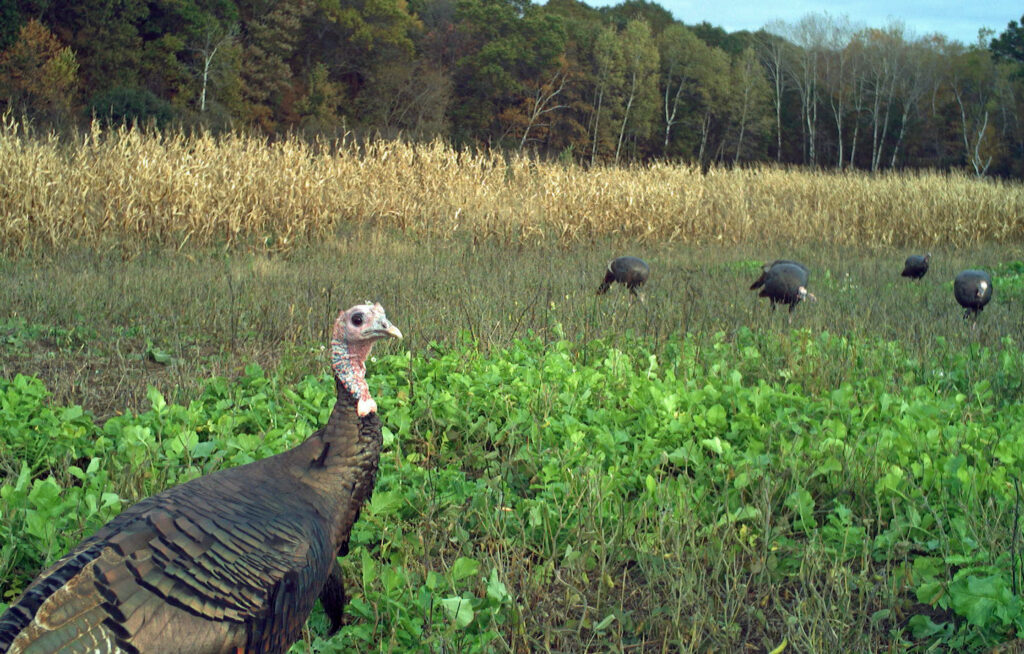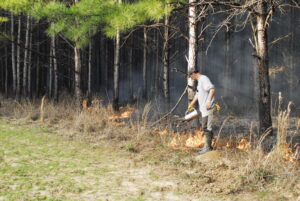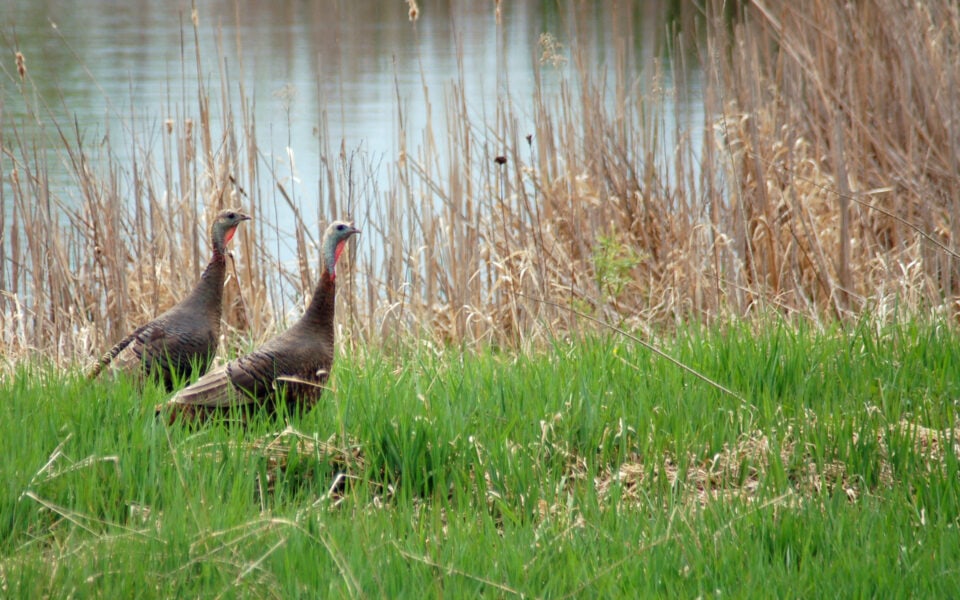In this three-part series, David Hawley of Mossy Oak Properties and the Wild Turkey Report will examine the hot topic of possible declines in wild turkey populations primarily in the Deep South, what wild turkeys need to thrive, and what you as a Gamekeeper can do to benefit wild turkey populations. This second part points out what we can do as gamekeepers. Pt.1 Southern Wild Turkey Populations: Temporary Dip or Long-Term Decline?
As a gamekeeper, YOU are responsible for taking the initiative to raise more wild turkeys on your property, and help to provide for them throughout their lifespan. It is not all up to The National Wild Turkey Federation or even the state’s game and fish commissions. While those organizations are critical in the effort by providing assistance and a framework to impact turkey populations, you are where the rubber meets the road.
The recent discussion about reducing bag limits and season length has reinforced my personal belief that regulatory measures will never truly bring about the proliferation or declination of a game species; there is always a human element involved, with that being the landowner or the person hunting those game species.
During the early 1990s, when turkey populations waned, it was concerned conservationists who slowly and methodically worked alongside state and national partners to bring turkey numbers back. That same spirit of “for the good of the resource” must exist in the heart of everyone passionate about wild turkeys to ensure we do not experience those days again.

While regulatory measures are a step and I personally support them if the resource simply needs that to flourish, they will all be for naught if hunters do not abide by them or simply expect those changes to be the silver bullet. Again, I feel regulatory changes are a step in a series of steps, many that fall on the shoulders of us landowners and conservationists to carry out. Let’s examine how you, as a gamekeeper, can positively impact turkey populations on the property you manage.
Wild Turkey Cooperatives
Just as whitetail managers have utilized cooperatives to positively impact white-tailed deer on a large scale, turkey management efforts will be more impactful if you are working in concert with adjoining landowners to achieve common goals. The key with any cooperative is the word in which it is derived – “cooperation.” If one landowner decides he will not go along with the plan and “pull his weight,” the full potential will not be realized. This is where the good of the resource must take priority and egos or personalities must be cast aside.
Cooperatives will enable smaller tracts of land to be managed as one, thus enabling a higher realistic level of success. Establishing a turkey cooperative may require an outside expert, such as a local NWTF biologist, to come in and provide recommendations for the total cooperative area. These recommendations may include reducing harvest numbers and changes to habitat, which may make some people uncomfortable, but again, the resource must be placed first.
Prescribed Burning
This should go without saying; “Do not attempt a prescribed burn without proper training, preparation and permits!”
Prescribed fire is without question one of the most beneficial tools for wild turkeys, especially in pine dominated forests. Once a pine plantation undergoes its first thinning, the opening of the canopy encourages new growth, some of which may not be beneficial to wild turkeys and other wildlife. Getting a pine plantation on a burn rotation is a great way to ensure it not only provides increased acreage for turkeys to be hunted in, but also to nest in and raise their brood. Ideally, you would want fire to increase the carrying capacity of your property by taking areas turkeys would not be able to use, and change it into productive ground.
 On our farm, we do cool season burns during the months of February and March. The nasty winter and early spring prevented us (and seemingly everyone in the South) from burning this past year, so we have some catch-up to play this fall and winter. Ideally, we will have alternating areas of burned and non-burned pine plantations so that we have a mosaic of habitats.
On our farm, we do cool season burns during the months of February and March. The nasty winter and early spring prevented us (and seemingly everyone in the South) from burning this past year, so we have some catch-up to play this fall and winter. Ideally, we will have alternating areas of burned and non-burned pine plantations so that we have a mosaic of habitats.
We typically strive for low-intensity burns, so we have started sectioning our plantations into 100 to 150 yard wide strips, which allow us to light backfires and slowly allow the fire to creep through the stand. This seems to be safer on the trees and fully consumes the layer of duff and debris on the forest floor.
If you have some plantations with heavy sweetgum or other woody plant infestation, talk to your forester about doing a “cool” August or September burn to kill back those woody plants heading into their dormant season. While these fires are riskier due to the warmer and drier conditions, they can be effective if executed properly, and you avoid the risk of burning up nests when done during this period. Smaller sectioning and backfires are typically the modus operandi when doing a late growing season burn.
An increasing number of wildlife managers are utilizing “cold” burns in hardwood stands to reduce duff, control unwanted species, and encourage positive regeneration. While this is not something I personally have experience in, those I know who have done it have been very pleased with the results. They have taken small sections, raked around the base of the larger desirable trees, and slowly burned these areas on very cold January or February days.
Lastly, cool season burning of warm season grasses is also beneficial in encouraging nesting and brood rearing habitat. In the Midwest, NWSG stands are oftentimes the primary nesting and brood rearing habitats, and these areas are fire dependent as well. As noted above, using fire safely and within the grand scheme of your management plan is important.
Nest Predator Control
 With nesting and brood rearing habitat part one of the baseline issue, in my opinion nest predator control is something every turkey aficionado should do. The reason being; if allowed by law of course, it is something you can do whether you are a landowner or lessee. Where a lessee may not be able to burn or do other major changes, they can give nests a fighting chance by implementing an aggressive nest predator program.
With nesting and brood rearing habitat part one of the baseline issue, in my opinion nest predator control is something every turkey aficionado should do. The reason being; if allowed by law of course, it is something you can do whether you are a landowner or lessee. Where a lessee may not be able to burn or do other major changes, they can give nests a fighting chance by implementing an aggressive nest predator program.
I believe in saturation trapping – in hammering the nest predators during the 3-4 months leading up to when eggs will first hatch so it will have maximum impact on the resident nest predators, and those transients that have filtered in. Because coons, possums, and skunks have smaller home ranges, they tend to filter into areas you have trapped a little slower than say a coyote or a bobcat. The downside is the numbers of nest predators per square mile are staggering. Estimates in some regions range from 50-60 coons per square mile and 150-200 possums per square mile! However, by hitting them hard when it counts, you can achieve results, especially when complemented by excellent habitat.
I use a combination of Duke dog-proof and cage-style traps, baited with dry cat food, mini marshmallows, cherry gelatin mix, and a topped with vanilla extract. I am currently running three dozen traps, and have concentrated my efforts around food sources such as deer feeders, as well as pinch points and road intersections where sign is present. While I once had strings of traps, I now place 4-5 traps in one location to play off the “pack nature” of coons. This strategy has proven to be effective.
Again, by saturating an area during the time period leading up to nesting season, you can have the most impact on the upcoming hatch. Just know that you’ll likely have to repeat the same process next year, and may get frustrated to find as many predators as before. This is typical and you must understand going in that predator control is simply something to make a part of your land management routine.
Poult Predator Control
Poult predators such as coyotes, bobcats, and foxes have a slightly narrower window in which they are most effective. Because these animals have larger home ranges, and can infill what you’ve trapped quickly, the best advice is to get a professional trapper to come in the day after turkey season ends to hammer these predators prior to poults hatching.
If you can eliminate 30 to 50% of the resident poult predators prior to that time frame, you are increasing the probability of success. That is really all we are trying to do – decrease the predator population the best we can and then allow Mother Nature to take it from there. Saving every poult is unrealistic, but our effort should aim for that goal.
Turkey Food Sources
 We have long been fans of planting chufas for wild turkeys, for their attractiveness and success in our sandier soils. The explosion of feral hogs has forced us to invest in building hog-proof fences, which have worked thus far in keeping hogs out. We are using shorter field fence (between 26” and 32”) with a strand of barbed wire at the bottom. Turkeys learned very quick that “gold” was inside the fence, and they have no issues jumping into the pens. We treat our fields with Poast and 2-4D, B to curb unwanted weeds.
We have long been fans of planting chufas for wild turkeys, for their attractiveness and success in our sandier soils. The explosion of feral hogs has forced us to invest in building hog-proof fences, which have worked thus far in keeping hogs out. We are using shorter field fence (between 26” and 32”) with a strand of barbed wire at the bottom. Turkeys learned very quick that “gold” was inside the fence, and they have no issues jumping into the pens. We treat our fields with Poast and 2-4D, B to curb unwanted weeds.
Clover is one of the best all-purpose food sources for turkeys, and Biologic’s Non Typical blend is an exceptional product. We manage our fields with planted and/or naturally reoccurring clover by spraying Weed Reaper (Clethodim) at a rate of 16 ounces per acre during the early spring. This kills the ryegrass and leaves a lush food plot in its wake.
These clover patches are very beneficial for brood rearing, as young poults love the lush clover and insects that call it home. If you have a wheat/clover food plot left over, an herbicide called Axial is generating buzz, as it will not kill wheat (only non-desirable grasses) and can be tank-mixed with 2-4D, B to kill any non-desirable broadleaf.
While on the subject of herbicide, we also like to spray our roads with Glyphosate to keep travel corridors open throughout the summer months. This helps broods visually avoid predators and provide all turkeys with easier access throughout the property.
Responsible Harvest
While my opinion is that the struggles we have experienced over the past several years are largely recruitment based, we still must discuss the role of responsible harvest during the spring season. While biologists have established that if gobbler recruitment is stable, gobbler harvest has minimal impact on the population, one must think that in periods of poor recruitment, excessive gobbler harvest can be impactful. This impact can be two-fold; first being a perception standpoint from fewer “carryover gobblers” sounding off the following season, and secondly being fewer gobblers to breed the available hens, and thus the chance a gobbler misses a hen’s window of fertility.
This “chance of infertility” is one reason why biologists are studying the possible impacts that shortening the seasons may have on recruitment success. The early hypothesis is later season start dates would present the highest numbers of hens being bred prior to the onset of hunter interference. If this is biologically proven, I would personally be for it. But as noted above, this is likely not the silver bullet.
Let’s return to gobbler harvest, using a purely hypothetical example. If a self-contained property has ten longbeards and ten jakes, and hunters kill three gobblers one spring, logic would suggest that more than ten gobblers will be available the following spring. If ten longbeards and only four jakes are present, and those hunters kill six of the ten, then it is realistic with natural mortality to expect less than 8 will be available the following spring.
This is why keeping a census via camera surveys and observation reports on how many gobblers call your property home, as well as how many jakes are coming up through the ranks, is important. Establishing a responsible harvest plan that ensures adequate levels of carryover gobblers to complement the jake crop can not only impact your following season, but those to come.
These decisions likely will not be totally impacted by changes in bag limits, as a hunter ultimately makes the decision on how many they cumulatively harvest off their property. Once a hunter is tagged out, they can always take others hunting unless you’ve established a responsible harvest plan that would limit those collective numbers to a practical level.
Final Thoughts
To bring everything home, while there are apparent declines in Deep South turkey populations, those trends can be reversed via a concerted effort by all landowners and agencies/organizations. By focusing sound management principles from the egg stage all the way to the freezer, we as gamekeepers can have positive impacts on the bird we love.










